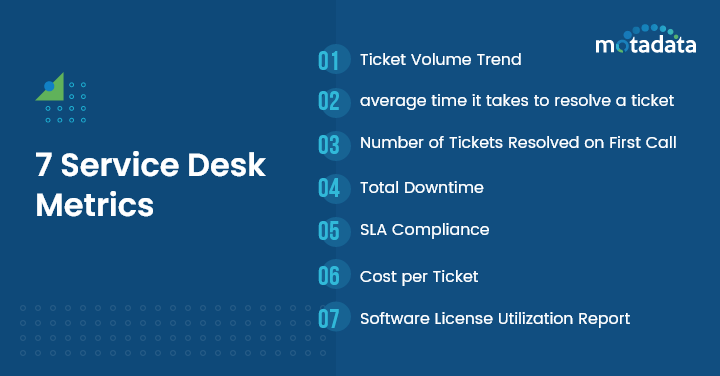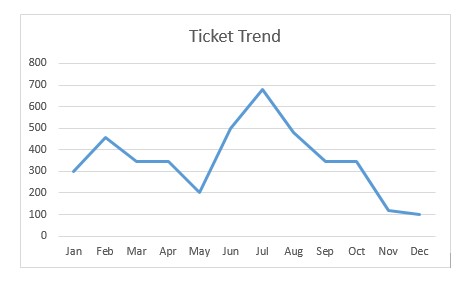Service desk or IT teams are critical to organisations for ensuring business continuity and service delivery.
Hence, it becomes important for IT organizations to use a slew of metrics to measure how efficient their service desk is.
With the recent advancement in IT Service Management (ITSM), the reporting capabilities offer multiple KPI metrics that can be measured and monitored.
So, with the increase in service desk metrics, it becomes even more difficult to zero down on which metrics to measure.
We will now discuss 7 KPIs that are aimed at achieving Productivity, Business Continuity, Timely service delivery and Control Cost.
Why Service Desk Metrics is Important
Service desk metrics are important for all those organizations that are always looking to optimize their support operations and improve customer satisfaction.
Measuring service desk metrics gives valuable insights into your support team’s efficiency and effectiveness.
Measuring these metrics also enables you to identify areas of improvement that can help you in effective resource allocation.
These metrics also draw a clear picture of how pleased your customers are with your support team’s performance.
This knowledge helps you to enable a customer-centric approach to service delivery.
Apart from the above, measuring service desk metrics help in:
- Aligning with SLAs
- Staff performance assessments
- Training strategies
7 Service Desk Metrics
1. Ticket Volume Trend
It is the total number of tickets that have come to service desk in a particular time frame.
Motadata ITSM dashboard allows for easy creation of line graphs to highlight ticket volume over a specific time frame.
Objective to measure the metrics
Analysis of monthly ticket volume would allow IT managers to optimize incidents and service request, that helps in handling the ticket load effectively.
Actionable for Service Desk Manager
1. Identify peak loads to optimize resource management
2. Create talent pool / increase bench strength
3. Identify training needs
2. The Average Time it Takes to Resolve a Ticket
This is one of the important metrics related to incident / ticket management, which summarizes the time taken to resolve all tickets divided by the no. of tickets.
In Motadata ITSM, service desk manager can create similar reports for individual technicians grouped by days, weeks or months.
Objective to measure the metrics
The report helps organization in planning and designing OLAs (Operational Level Agreement) and SLAs (Service Level Agreement). It also helps in measuring individual / team productivity.
Actionable for Service Desk Manager
1. Analyze service request patterns to build a robust knowledge base to resolve common issues i.e. password reset
2. Automate manual activities with workflow automation, so as to reduce the time required in assigning ticket manually
3. Properly prioritize and categorize tickets to reduce incorrect ticket assignments
4. Categorise and tag similar tickets so as to reduce the time wasted by multiple agents in resolving the same set of issues individually
3. Number Of Tickets Resolved On First Call
A ticket is considered as resolved on the first call when it’s resolved at a tier 1 level and doesn’t have a comment thread with more than 2 comments.
In Motadata, the report can be grouped by technicians and can be generated for a specific time period.
Objective to Measure the Metrics
It helps IT managers to measure the service desk efficiency and allocate technicians across different levels of support based on their expertise.
Actionable for Service Desk Manager
1. Analyze service request patterns to build a robust knowledge base to resolve common issues i.e. password reset
2. If the calls are not resolved on first call, training needs could be identified so as to upgrade technician’s skill.
3. Create detailed form so as to collect and capture all the relevant information that would be required in order to resolve user tickets.
4. With workflow automation, automatically route tickets to the right technician or group.
4. Total Downtime
Downtime refers to the duration during which critical services of IT were not available. IT managers can sum-up the resolution time of such tickets (Created by the NMS tool) to ascertain the total downtime.
Motadata ITSM can be integrated with any NMS tool, that allows automatic creation of tickets in the event of system failure.
Objective to Measure the Metrics
Keep lost business hours to the bare minimum due to unavailability of IT services. Additionally, this practice aids IT managers in determining whether their IT is delivering the promised level of services as defined in the Service Level Agreement (SLAs).
Actionable for Service Desk Manager
1. Properly plan application upgrades, server migration, and other IT change related processes.
2. Sensitize IT teams on the indirect cost incurred by businesses in case of IT Failure
3. Prepare IT teams to analyse the past and anticipate future outages for effectively handling service desk
5. SLA Compliance
A ticket incident/request is considered violated, when it’s not resolved within the time stipulated in the associated SLA.
The compliance report in Motadata ITSM, gives the total count of SLA violations for a particular period. i.e. % of tickets resolved within the agreed SLA.
Objective to Measure the Metrics
It helps in measuring the number of times SLA has been violated.
Actionable for Service Desk Manager
1. Match business expectation with IT Capabilities to set achievable SLAs
2. Sensitize IT teams on business impact due to SLA violations
3. Set escalation matrix, in case SLA’s are violated
6. Cost per ticket
It is the operating cost of running IT support divided by the total number of tickets during a particular period.
Objective to Measure the Metrics
Keep in-check the cost incurred per ticket, which is crucial for budgeting.
Actionable for Service Desk Manager
1. Identify technician training needs, to keep the cost in control
2. Logical workflow automation to assign tickets to right technician
3. Create a robust knowledge base
7. Software License Utilization Report
The report indicates how many licensed software installations are across the organization compared to what was procured. It directly influences the decision on how many licenses to purchase for a particular software.
Objective to Measure the Metrics
The report helps in optimizing the ROI on cost incurred to procure software licences. It also lets you measure, over and underutilization of licensed software.
Actionable for Service Desk Manager
1. If the number of licenses procured exceeds the license in-use, the service desk manager has to optimize the software utilization, so as to plan future procurement effectively
2. Sensitize IT Teams and employees on the risk of using pirated / unlicensed software’s.
Common Mistakes while Setting Service Desk Metrics
Selecting the wrong metrics: Every metric should serve a specific purpose. When deciding on a metric ask yourself what is the purpose that it is going to be solved.
1. Selecting Too Many Metrics:
Current ITSM tools allow for a wealth of reports that measure various metrics. IT teams need to select the right metrics to be measured, that affects the cost and performance of service desk.
2. Metrics Not Aligned To Business Outcomes:
A good metric if misaligned with business, will be of no use. An ideal metric should be measurably against business expectations.
3. Ignoring Context:
Analysis of a metric shouldn’t be one dimensional. It should also build business context by taking into consideration multiple metrics i.e. more than one set of data points.
4. Blindly Follow Industry Benchmark:
Industry standards can be misleading if you don’t understand the uniqueness of your organization. Industry benchmarks which are applicable to the world-at-large may not be applicable to your business.
5. Not Updating Your Metrics:
Organizations evolve with time, and hence IT teams have to keep their metrics up-to-date so as to adhere to the new benchmarks.
4 Best Practices to Improve Service Desk Metrics
1. Only Track Those Metrics That Are Relevant to Your Business
In this blog, we discussed service desk metrics, which represent just a small portion of the overall service desk metrics that exist.
A handy service desk metrics practice would be to track only those metrics that have the maximum impact on your business.
After all, it’s always better to track 5 relevant metrics than tracking 20 of them just because your competitor is doing so.
2. Make Customer Satisfaction (CSAT) Your Priority
Out of all the metrics, CSAT certainly tops the chart. If you do good in this, you’ve already won half the battle. Improving customer satisfaction is all about offering value to your customers.
The best scenario to evaluate this metric is when they have a complaint.
At that time, you must measure if the customers are satisfied with the way you address and resolve their complaints.
The best way to boost this metric is to aim for a higher survey response rate.
Utilizing Best and Affordable Customer Engagement Tools can help streamline survey distribution and improve participation rates.
For this, you can enable customers to share their feedback with a simple yes or no or thumbs up/thumbs down surveys.
And, if you get negative feedback, do ensure that you follow up with the customers.
Here, your aim should be to understand the reason behind their negative feedback.
3. Offer Self-service Options
According to the Harvard Business Review, around 81% of customers prefer self-service before reaching out to a support rep.
If this isn’t a big enough reason to deploy self-service, you should also know that self-service can:
- Reduce Service Desk Workload
- Enable 24/7 availability and accessibility
- Improve Customer Experience
4. Automate via AI
Today, AI has millions of use cases. Out of this, automating repetitive tasks pertaining to service desk is the one that you shouldn’t miss out. With AI, you can automate tasks such as:
- Ticket categorization
- Instant responses
This automation will do wonders for your support team. It’s because it will not only reduce response time but also enhance overall efficiency.
Conclusion
Implementing metrics are vital for measuring the performance of your service desk and to ensure its health.
Hence, it is equally important to have the capability to implement such metrics which is where a robust ITSM solution comes to the rescue.
Try 30 days free trial of our ITSM solution which has an inbuilt reporting module.





